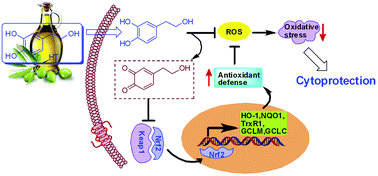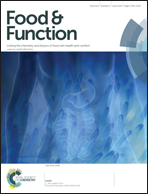Dual protection of hydroxytyrosol, an olive oil polyphenol, against oxidative damage in PC12 cells†
Abstract
Hydroxytyrosol (3,4-dihydroxyphenylethanol, HT), a major polyphenol in olive oils, has received increasing attention due to its multiple pharmacological activities. However, it is not well understood how HT works on the neuronal system. We report herein that HT efficiently scavenges free radicals in vitro and displays cytoprotection against oxidative stress-induced damage in PC12 cells. HT completely protects the cells from hydrogen peroxide-induced death and rescues the cells from 6-hydroxydopamine-induced damage. Mechanistic studies reveal that Nrf2 is a prerequisite for the neuroprotection of HT as knocking down Nrf2 eliminated this action. HT, via activation of the Keap1-Nrf2 pathway, elevates a panel of cytoprotective enzymes, including glutamate–cysteine ligase, HO-1, NQO1 and thioredoxin reductase. Our study reveals that HT provides dual neuroprotection and cellular antioxidant defense as both a free radical scavenger and Nrf2 activator, suggesting the potential pharmaceutical usage of HT for the treatment of neurodegenerative disorders.


 Please wait while we load your content...
Please wait while we load your content...